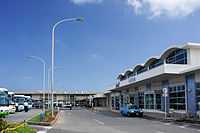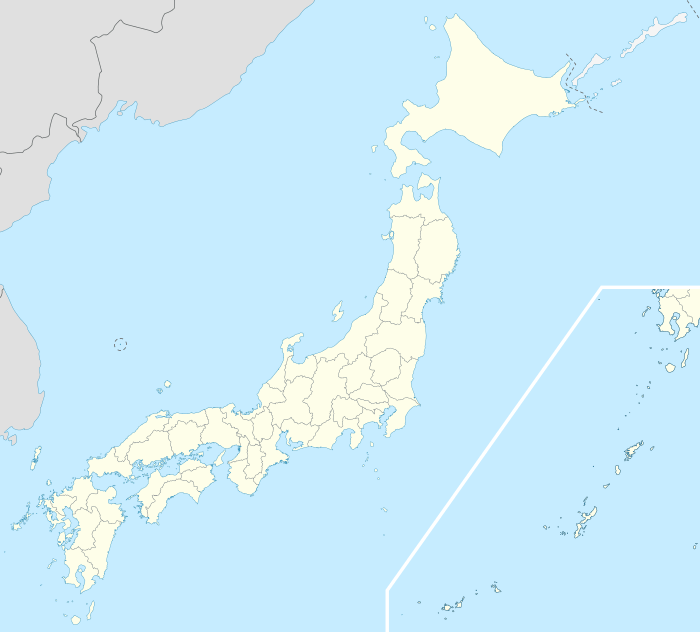Ishigaki Airport
| Ishigaki Airport Ishigaki Airport 石垣空港 Ishigaki Kūkō | |||||||||||
|---|---|---|---|---|---|---|---|---|---|---|---|
 | |||||||||||
| IATA: ISG – ICAO: ROIG | |||||||||||
| Summary | |||||||||||
| Operator | Ministry of Land, Infrastructure and Transport | ||||||||||
| Location | Ishigaki, Okinawa, Japan | ||||||||||
| Elevation AMSL | 86 ft / 26 m | ||||||||||
| Coordinates | 24°20′41″N 124°11′13″E / 24.34472°N 124.18694°ECoordinates: 24°20′41″N 124°11′13″E / 24.34472°N 124.18694°E | ||||||||||
| Map | |||||||||||
 ROIG Location in Japan | |||||||||||
| Runways | |||||||||||
| |||||||||||
Ishigaki Airport (石垣空港 Ishigaki Kūkō), (IATA: ISG, ICAO: ROIG) was a third-class airport located 1 NM (1.9 km; 1.2 mi) from Ishigaki city centre in Okinawa Prefecture, Japan. The airport provided flights to major cities on the Japanese mainland as well as destinations throughout Okinawa Prefecture and the Yaeyama Islands. Commercial operations at Ishigaki Airport ceased at midnight on March 6, 2013, and New Ishigaki Airport opened on March 7, 2013.[2][3] As of mid-2013, the possibility exists that the airport may be turned over fully to the Japanese Self-Defense Forces. As a Type-3 airport, the JSDF was already in theory able to carry out operations from Ishigaki.
History
The airport was opened in 1943 for military use, and converted to a civilian airport in 1956.[3] The runway was extended from 1,200 to 1,500 m (3,937 to 4,921 ft) in 1968, allowing YS-11 aircraft to land.
Southwest Air Lines Flight 611
| Overrun summary | |
|---|---|
| Date | 26 August 1982 |
| Summary | Runway overrun |
| Site | Ishigaki Airport |
| Passengers | 133 |
| Crew | 5 |
| Injuries (non-fatal) | 67 |
| Survivors | 138 (all) |
| Aircraft type | Boeing 737-200 |
| Operator | Southwest Air Lines (now Japan Transocean Air) |
| Registration | JA8444 |
| Flight origin | Naha Airport, Okinawa, Japan |
| Destination | Ishigaki Airport |
Flight 611 of Southwest Air Lines (now known as Japan Transocean Air, and not the Dallas, USA-based airline) is the only significant aircraft accident on record at Ishigaki Airport. The accident occurred on 26 August 1982 when the Boeing 737-200 overran the runway while attempting to land. The aircraft caught fire and was destroyed, but none of the 133 passengers and 5 crew died in the accident although two crew and one passenger were seriously injured.[4]
Southwest Air Lines Flight 611 took off on runway 36 from Naha Airport on the island of Okinawa[note 1] at 13:09 for a regular flight to Ishigaki Airport, Japan. The aircraft climbed to the cruising altitude of Flight level 240 (approximately 24,000 ft/7,315 m). On approach to Ishigaki, the crew was given weather information for Ishigaki — wind 300 degrees at 12 knots; temperature 32 degrees C (89.6 degrees F); active runway: Runway 22. The crew of Flight 611 made a crosswind landing at a speed slightly higher than the reference airspeed. The aircraft bounced and on touching down again the spoilers and thrust reversers did not seem to operate. The flight crew shut down both engines but this action disabled the anti-skid braking system, and during the landing rolls the inner tires on both main gear legs burst almost simultaneously. Flight 611 overran the runway and came to rest 145 meters (476 feet) beyond the threshold at 13:49. Everyone on board was evacuated. At 14:01 the Boeing 737 caught fire and was destroyed.
None of the 138 passengers and crew were killed in the accident, but 67 were injured. Serious injuries were prevented by a quick evacuation although a stewardess and an elderly woman passenger were detained in hospital. [5]
Restruction
The airport served about 1.8 million passengers a year, making it the second busiest third-class airport in Japan, behind Kobe Airport, and traffic grew steadily as the Yaeyama Islands become a popular tourist destination. The runway of Ishigaki Airport could not accommodate planes larger than a Boeing 737, and the present site was not suitable for expansion due to urban encroachment. The airport also did not have facilities for handling standard cargo containers.
To meet these needs New Ishigaki Airport was constructed on the eastern side of the island, replaced Ishigaki Airport. Plans for the new airport dated to 1979, when the prefectural government planned to build a 2,500 m (8,202 ft) runway by the shore of the Shiraho (白保) district. However, due to concerns about coral, the residents of Shiraho long opposed the project. In addition, historical artifacts from the Shiraho Saonetabaru Cave Ruins some 18,000 to 15,000 years old were discovered, affecting the timeline of the project.
The new airport has a 2,000 m (6,562 ft) runway, expandable to 2,500 m (8,202 ft). Construction started in October 2006, and the new airport opened in 2013.[6]
Notes
- ↑ The ASN accident synopsis states that the departure point was Naha Airport in Indonesia; however, the runway at Naha, Indonesia, is oriented in a different direction and is too short for Boeing 737 operations. The airline was based at Naha, Okinawa, and had never operated to Indonesia. The flight from Indonesia to the accident airport took more than three hours
References
- ↑ AIS Japan
- ↑ Ealey, Mark (7 Mar 2013). "New Ishigaki Airport holds opening ceremony". Ryukyu Shimpo (Naha, Okinawa Prefecture, Japan: Ryukyu Shimpo). Retrieved 2013-03-26.
- ↑ 3.0 3.1 "石垣空港" [Ishigaki Airport]. Nihon Rekishi Chimei Taikei (in Japanese). Tokyo: Shogakukan. 2013. OCLC 173191044. dlc 2009238904. Retrieved 2013-03-13.
- ↑ CAP 479 World Airline Accident Summary (United Kingdom Civil Aviation Authority) Page 16/82
- ↑ "Narrow escape for 138 in jet" The Times (London). Friday, 27 August 1982. (61322), p. 5.
- ↑ (New Ishigaki Airport) (Japanese)
External links
| Wikimedia Commons has media related to Ishigaki Airport. |
- Ishigaki Airport
- New Ishigaki Airport (in Japanese)
- Ishigaki Airport Guide from Japan Airlines
- Aviation Safety Network
- Current weather for ROIG at NOAA/NWS
- Accident history for ISG at Aviation Safety Network
| ||||||||||||||||||||||||||||||||||